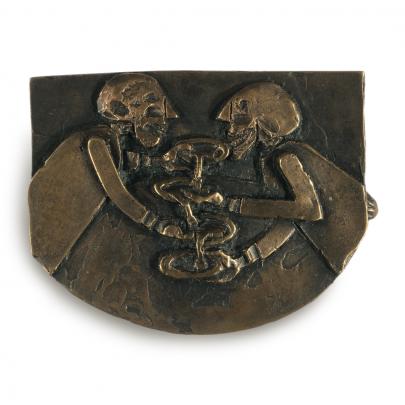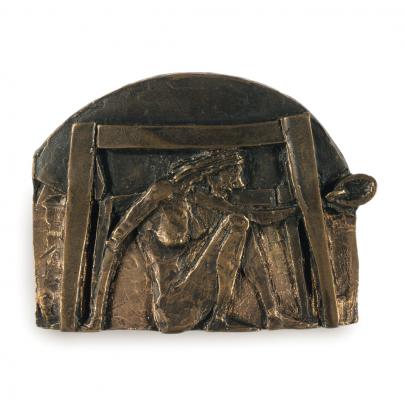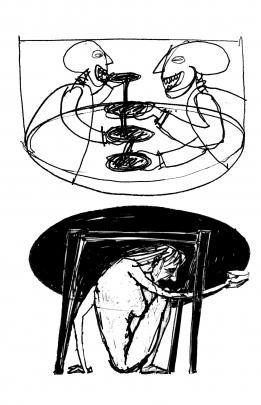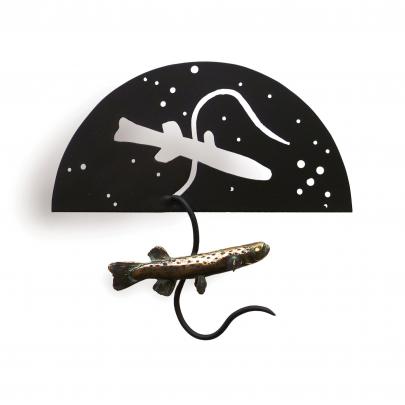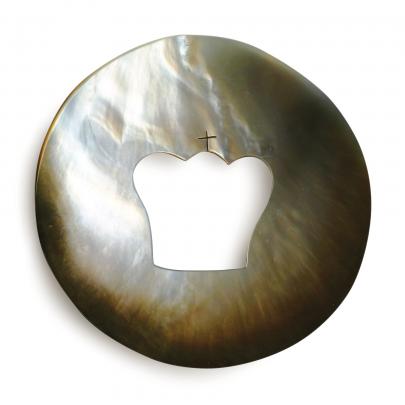The medals in an exhibition at the Forrester Gallery are not from the general’s chest, writes Tom McKinlay.
Two grinning grotesques share the spoils of the "trickle down" economy in a work by Christchurch artist Michael Reed, denying any crumbs to those who scrabble beneath the table.
It’s a fist-shake of defiance from the early ’90s, following years of Business Roundtable-inspired agenda setting. All this, set out graphically and unmistakably on a medal, front and back. A small work then, by weight and area, but one that carries a powerful message out into the world.
The piece is one of more than 200 in an exhibition opening next week at the Forrester Gallery in Oamaru — "Regroup Reflect Regenerate" — by the Medal Artists of New Zealand. It was first staged last year in Auckland to mark the group’s 25th anniversary.
Another of the 33 artists involved, sculptor Richard Mathieson, describes medals as "portable message carriers", a purpose Reed’s work certainly satisfies. An example of Trickle-Down Economics/Life Under the Round Table, cast in bronze in 1993, now resides at the British Museum, as part of the coins and medals collection.
Reed, best known as a printmaker, says the appeal of making medals is the challenge of fitting a message on to what is a ‘‘small scale, hand-held object’’. It places the medal maker in a tradition: they’ve always been loaded with meaning, he says.
"There is a history of social comment. It hasn’t always been the hierarchy awarding their minions or recognising worthy deeds," he says, even if there has been plenty of that.
"The other side of the medallion is that two-sided aspect."
When you flip over Trickle-Down Economics there is a woman, bowl in hand, representing the recipients of the "generous" trickle down, Reed says wryly.
"So from a design point of view, from my point of engagement, having something where the story continues on the other face is very appealing."
In the medallion game, the principal face, shown to the world, is known as the obverse. The other is the reverse.
Reed is currently working on a medal about World War 1 that he will take with him to a residency in Belgium next year. It features the boot tread worn by soldiers, which Reed walks through damp clay, as mud beneath their boots was the common experience of the combatants in all trenches. It’s about lost opportunity and lost youth, he says.
There will be text on the reverse side.
Philip Attwood, keeper of coins and medals at the British Museum, says it is a requirement of the form that the medal should fit in the hand, its size serving to concentrate the maker’s mind: "there is space only for the essential".
Besides Reed’s work, the medals in the exhibition carry all sorts of concentrated, essential messages.
Oamaru sculptor Bing Dawe, another member of the group, has work included. It continues a series, Small Fry From Out of a Night Sky — From the Family Galaxiidae, that re-examines the place of the humble galaxiid, or whitebait. His medals show the fish, which Dawe says are at risk from polluted water and habitat destruction, reflected in a galaxy of stars, elevating "their size, importance and the implications of their loss to a grand scale".
These, then, are not the medals of the military parade. But they share a great deal.
Both the art medal and the commemorative medal continue a tradition begun in the Renaissance, which in turn looked back to the coins and medallions of the classical age. Towards the end of the 19th century medallic art found renewed popularity in Europe and in 1937 the Federation Internationale de la Medaille (FIDEM) was formed. The New Zealand group formed in the late 1980s around the work of Prof Paul Beadle, a lecturer at Elam School of Fine Arts in Auckland, with just six members.
Founding member and FIDEM delegate Christine Massey says she likes "the fact that art medals are multisensory, involving sight, sound, touch and weight, temperature, time (the turning over to another side) and the duality of concept. To me they are hand poems."
Forrester Gallery director Jane Macknight says the exhibition is a great selection of well-known New Zealand artists from across the country, seasoned practitioners in their fields.
"I also like [the exhibition] for Oamaru because it has the artisanal side, which a lot of the art and craft people in Oamaru are attracted to, the making side," Macknight says.
"And I am interested in the making side, I think that has been overlooked over the past 10 to 20 years. The craft, the art of making things."
Media include bronze and other metals, stone, shell and painted board.
"They draw you in," Macknight says of the works.
"You do need to take the time. You don’t walk in to be confronted by a large work on the wall, you need to walk up and look closely and take your time with them. They do unfold a bit the longer you spend with them."
Three of the artists have also contributed working material, including sketches, to be put on display to show how they developed their ideas.
Earlier in the year the Victoria Cross of Oamaru man Donald Forrester Brown, and other family medals, were on display at the North Otago museum, which Macknight says was popular.
"But that’s a particular kind of medal of course. A lot of people will find ["Regroup Reflect Regenerate"] different, but that’s one of the aims of having art exhibitions, to challenge and expand people’s thinking."
The exhibition
• "Regroup Reflect Regenerate: Medal Artists of New Zealand 25th Anniversary Exhibition" is at the Forrester Gallery from Saturday December 17 to Sunday February 12.

